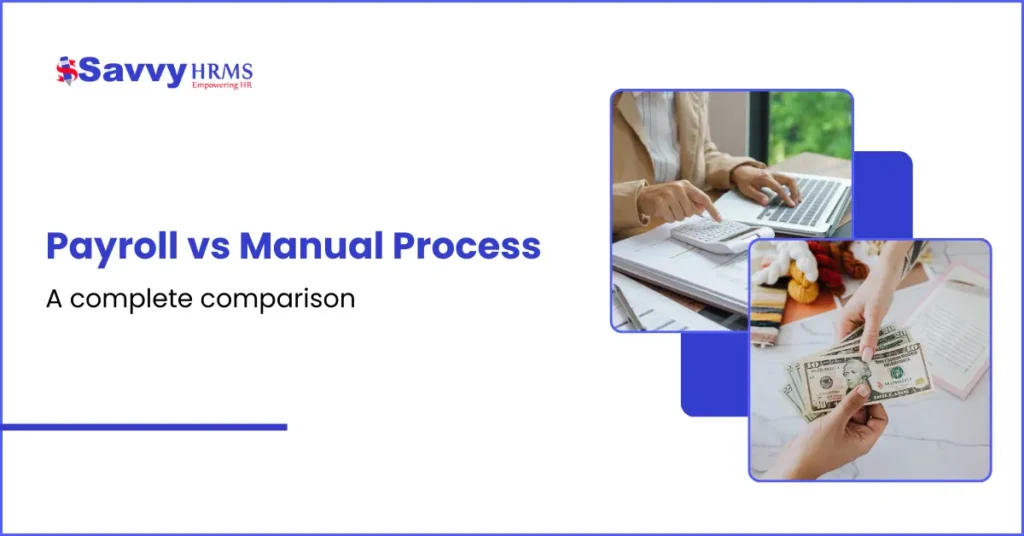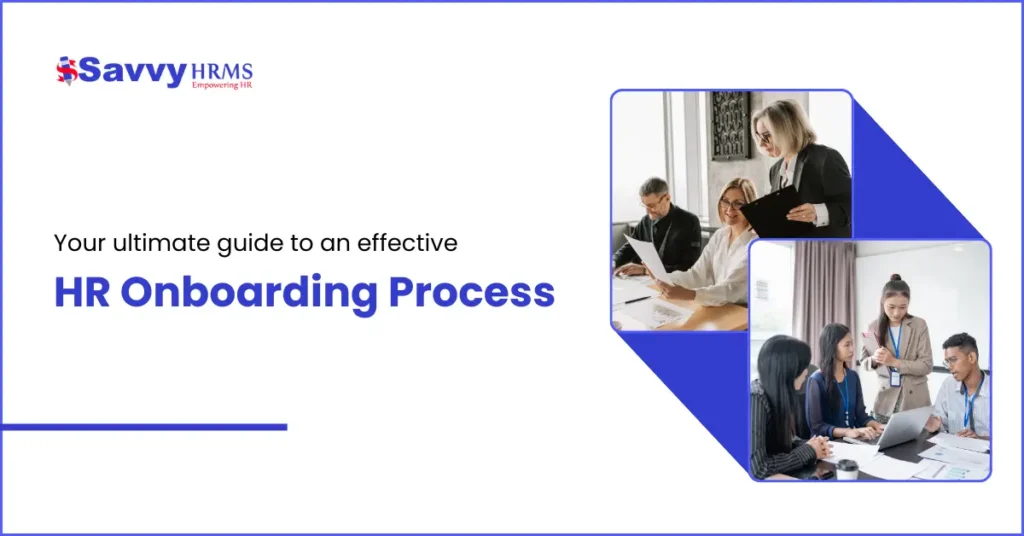Handling employee compensation accurately and on time is a foundation of every successful organization. Whether it’s about paying wages, tax deductions, salary distribution, or managing benefits, payroll is an important function that impacts employee satisfaction and business compliance. However, how your organization manages payroll can vary accordingly, from manual spreadsheets & paperwork to automated payroll software. Selecting the right one is important to ensure efficiency and accuracy within your organization.
Traditional manual payroll processing has been around organizations for a long time. Many small companies still depend on the manual payroll process due to simple payroll needs. But with the growing size of organizations, the manual payroll method becomes outdated and time-consuming. At the same time, modern payroll software brings automation, integration, and scalability to face the complicated payroll challenges.
What is automated payroll and manual processing?
An Automated Payroll is the process of calculating and distributing employee incentives, including salaries, bonuses, tax deductions, and other benefits. It involves various steps such as salary attendance tracking, applying tax rules, calculating gross tax, generating payslips, and ensuring compliance with labor laws. Automated payroll processing not only ensures that every employee is paid on time but also maintains the organizational credibility and legal compliance.
Manual payroll processing is the process of managing all the financial and HR work through human intervention. Payroll teams collect and enter all the attendance data manually into spreadsheets or paper records, calculate salaries and deductions by hand, and prepare payslips independently. This method still requires more paperwork, and always demands the payroll specialist to be aligned with the up to date with changing laws and regulations.
Automated Payroll vs manual payroll processing: A complete comparison
Automated Payroll processing is an important function for every organization, ensuring employees’ salaries are distributed on time while aligned with tax and legal requirements. Although most of the organizations still handled manual payroll processing, depending on spreadsheets, paperwork, and physical calculations, it gives total control and personalization, but is labor-intensive and time-consuming, especially when the size of the organization increases and regulations become more difficult.
On the other hand, payroll software automates the whole process, simplifying data entry, calculations, tax filings, and reporting. Automated payroll software saves time, reduces errors, and improves compliance by aligning with the regular changes in tax laws. It provides easy integration with attendance and HR systems, boosting the overall productivity within the organization. This transition from manual to automated payroll is not only about technology, but transforming how organizations can manage one of the most difficult tasks.
Here’s the complete comparison between automated payroll and manual payroll processing:
| Aspect | Automated payroll | Manual payroll |
| Accuracy | Strong accuracy from automatic calculations and error checks. | Human errors in calculations and data entry. |
| Time efficiency | The payroll process in minutes and automates the repetitive tasks. | Time-consuming, requires hours of manual work and cross-checking. |
| Compliance | Automatically updated with updated laws and regulations. | Requires continuous manual monitoring to avoid penalties. |
| Cost | Cost must be high, but long-term labor and error costs. | Lower initial cost, but errors and insufficiencies are higher. |
| Scalibilty | Simplify the employee growth and complex payroll needs. | It’s difficult to scale and slow employee growth. |
| Data security | Secure cloud storage with encryption and access control. | Risk of data loss due to manual processing. |
| Integration | Smoothly integrates with HR, accounting, and attendance systems. | Some disconnected systems require manual data entry and transfer. |
| Reporting & transparency | Real-time reports and insights for better decision-making. | Limited reporting requires manual compilation. |
| Employee accessibility | Employee self-service portals are available for pay slips and tax documents. | Employees depend on HR for any queries and documentation |
| Disaster recovery | Automated backups prevent the loss of data. | Risk of data without any backup systems. |
| User experience | User-friendly interface simplifies the payroll for all employees. | Difficult processes need a trained professional. |
Why does your organization need a automated payroll system?
1. Ensuring accuracy and compliance
Investing in an automated payroll system is no longer just an option, but it’s a necessity for every organization looking for smooth operations and compliance. This software eliminates errors by accurate calculations of wages, deductions, and taxes that are based on up-to-date laws and regulations. This accuracy prevents costly penalties and builds trust between employees and managers.
2. Saving time and improving productivity
Time saving is another important reason. Payroll management software reduces the hours of manual work that are spent on calculations, approvals, and report generation, freeing HR teams to focus more on strategic planning, such as talent management and organization growth. It also improves employee satisfaction by providing faster salary distribution and easy access to payslip information.
3. Strengthening data security
As the security of data is important for every organization, this system also gives a sensitive nature of payroll data. A modern payroll system gives strong encryption and access controls to protect employee information, lowering the risk of data loss due to manual processing.
4. Smooth integration for better efficiency
Moreover, the payroll system easily integrates with the attendance, leave, and other management systems that offer a complete view of employee management. This interconnection simplifies workflows, improves transparency, and supports decision-making.
5. Scalable future growth
Finally, scalability enables the payroll process to grow with your organization’s growth. Whether your organization hires ten or more employees, automated payroll processing handles growing difficulties easily, saving you from scalability challenges that are difficult with the manual method.
How to Choose the Right Payroll System?
1. Assess Your Business Needs
Evaluate the size of your organization, the difficulty of payroll (such as multiple places, countries, or types of employment), and specific features you need, like tax calculations, benefits integration, and compliance management.
2. Check Compliance and Security Features
Ensure the payroll system aligns with the correct local labor laws and tax regulations. Verify it has strong security measures to protect sensitive financial and employee information.
3. Look for Integration Capabilities
Choose payroll software that can smoothly integrate with your existing HRMS, accounting, and time-tracking systems to minimize data entry errors and simplify workflows.
4. Evaluate Automation and Self-Service Options
Choose a system that automates calculations, tax filing, and payslip distribution. Self-service portals for employees and managers improve transparency and minimize manual queries.
5. Consider User-Friendliness and Support
The system should have an insight interface accessible to HR leaders and employees. Also, check the quality of provider support, including training, troubleshooting, and system updates.
6. Review Pricing and Scalability
Understand the pricing model, whether it’s per employee, per month, or flat fee, and check if it fits your budget. The software should be scalable to accommodate organizational growth and changes.
7. Trial and Feedback
Request a demo or trial period to test the software. Look for feedback from actual users across HR, finance, and employees to ensure it meets practical daily needs.
Why Choose Savvy HRMS?
Savvy HRMS stands out as a complete payroll solution built to meet the strong needs of modern organizations. Its strong platform combines ease of use with powerful automation, enabling organizations to manage payroll processes correctly and efficiently. With integrated compliance updates, Savvy HRMS reduces the risks of regulatory penalties and ensures peace of mind for HR and finance teams.
Moreover, Savvy HRMS provides smooth integration with other HR modules like attendance management, leave management, and employee self-service portals. This integrated environment minimizes manual work, improves data accuracy, and overall HR operational efficiency. The accessibility of the platform through mobile and web provides flexibility for remote and process management.
Finally, Savvy HRMS is built by a dedicated customer support team committed to helping clients maximize the system’s benefits. Regular software updates and personalized training ensure organizations stay ahead with the latest payroll technologies and best practices. Selecting Savvy HRMS means gaining a trusted partner for simplified payroll management and continued organizational growth.
Conclusion
Although manual payroll processing seems to be good for small organizations, it is impractical and impossible in a modern organizational environment. Automated payroll systems offer advantages in accuracy, efficiency, security, and compliance.
By choosing an automated payroll software, organizations not only reduce the manual work burden and errors, but also empower HR leaders to contribute more to strategic decisions and provide employees with a transparent and smooth payroll process. Transforming to an automated payroll system is an investment that pays dividends in operational excellence and peace of mind, making it an important one for every organization, resulting in scalability and productivity.


